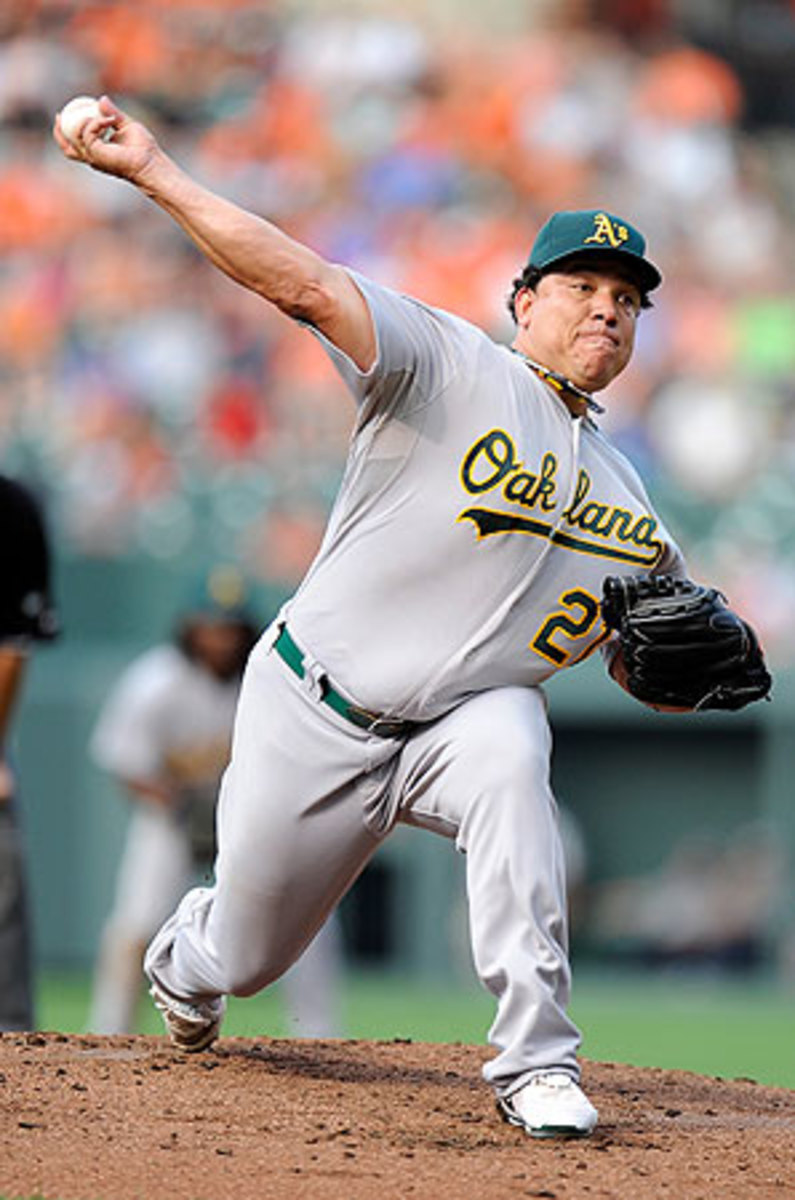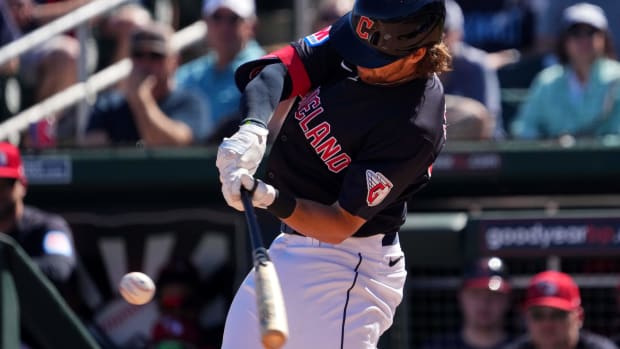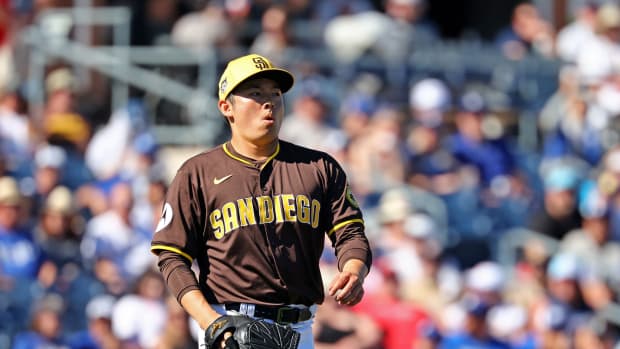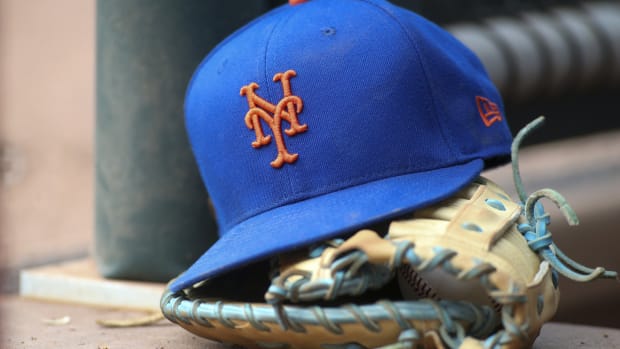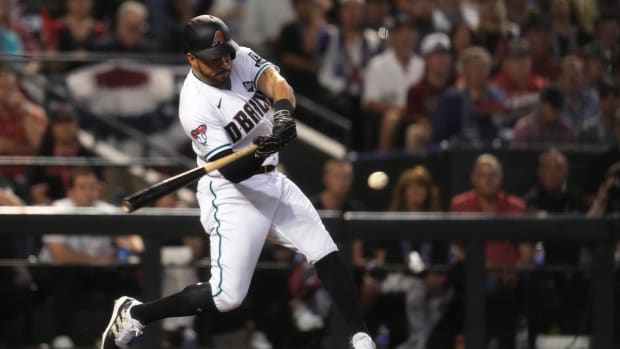Suspensions of Colon and Cabrera show system does work
Bartolo Colon was suspended for 50 games Wednesday after testing positive for elevated testosterone. (G Fiume/Getty Images)
Another week, another feel-good comeback story interrupted by a suspension for performance-enhancing drug usage, leaving a contending team scrambling to fill the resulting void. Last week, Major League Baseball rung up the Giants' Melky Cabrera for failing a urine test due to elevated testosterone levels, and suspended him for 50 games. On Wednesday, they did the same for the A's Bartolo Colon.
The 39-year-old Colon wasn't overachieving to the same extent as the 27-year-old Cabrera, who had emerged as a threat for the NL batting title, with an outside shot at MVP honors. But if anything, the portly righthander had come back from an even closer brush with baseball oblivion. From 1997 through 2005, Colon was a front-of-the-rotation workhorse for the Indians, Expos, White Sox and Angels, but en route to winning the 2005 AL Cy Young award, he left a Division Series start in the second inning due to a torn rotator cuff. He spent the next four seasons lost in a wilderness of poor performance and injury while bouncing from the Angels to the Red Sox to the White Sox, putting up a 5.18 ERA, never making more than 18 starts in a season, and totaling more days on the disabled list (420) than innings pitched (257). Frustrated by his progress and the way he was used, he bolted both Boston and Chicago midseason, then sat out all of 2010.
Colon re-emerged with the Yankees last year after undergoing a controversial, cutting-edge medical procedure in which fat and stem cells from his bone marrow were injected back into his elbow and shoulder in an effort to repair his torn rotator cuff and damaged ligaments. Relying almost exclusively on a mix of two- and four-seam fastballs -- which he could still pump into the mid-90s on occasion -- he posted a 4.00 ERA in 164 1/3 innings, striking out a respectable 7.4 per nine. He led the majors in strikeouts looking thanks to outstanding movement and pinpoint control, ranking 10th in the AL with a 3.38 strikeout-to-walk ratio. The Yankees opted not to retain him, so he signed a one-year, $2 million contract with Oakland, where he was expected merely to eat innings at the back of the rotation while other pitchers recovered from injuries or matured in the minors. Instead, he spearheaded a rotation that ranks second in the league with a 3.80 ERA, putting up a 3.43 ERA himself over 24 starts and 152 1/3 innings, both team highs. Though his strikeout rate dipped to 5.4 per nine, his 4.0 strikeout-to-walk ratio still ranked fifth in the AL, and his percentage of strikeouts looking ranked first.
Colon's stem cell treatment, which took place in the Dominican Republic drew a great deal of scrutiny from MLB because of fears that human growth hormone was involved. The orthopedic surgeon who performed the operation, Dr. Joseph Purita, had used HGH on other patients but denied using it on Colon, and ultimately MLB's investigation found no wrongdoing. HGH wasn't involved in Colon's positive test; MLB only began screening for it via a blood test this spring, and has yet to strike an agreement with the players' union to do so in-season. Colon's positive test was for synthetic testosterone, though how it was administered has yet to be reported. At least publicly, the pitcher didn't put the blame on having unknowingly ingested a supplement that contained testosterone, a tack taken by some recently suspended players (J.C. Romero and Guillermo Mota come to mind), and one Cabrera was attempting to take when MLB 's investigation uncovered his scheme.
Colon's suspension is the fifth among major leaguers this season, following those of the Giants' Mota (who drew a 100-game suspension for a second offense), the Phillies' Freddy Galvis, free agent Marlon Byrd, and Cabrera. At the major league level, that's more suspensions than occurred in 2010 and 2011 combined, when Cincinnati's Edinson Volquez, Florida's Ronny Paulino, Tampa Bay's Manny Ramirez and Colorado's Mike Jacobs all tested positive, the latter becoming the first player suspended for via HGH testing. Depending upon whom you listen to, that's either evidence that the game's Joint Drug Agreement is actually working, or that PED use remains rampant. On the one hand, the testing program continues to evolve, with the league adding the HGH blood test, improving its collection procedures in the wake of Ryan Braun's overturned suspension and more closely scrutinizing urine tests where the testosteone-to-epitestosterone ratio is under the 4-to-1 benchmark that triggers further analysis via a Carbon Isotope Ratio (CIR) test.
On the other hand, Victor Conte, who as the founder of the Bay Area Laboratory Co-Operative was at the epicenter of the game's largest drug scandal a decade ago, claimed last week that "as much as half" of all current players are using PEDs, and that current tests are easy to circumvent. "What these guys are doing is using fast-acting testosterone, creams, gels, patches and micro-dose injections," he told USA Today's Bob Nightengale. "They put this stuff on after a game, let it circulate in their blood stream, and eight hours later, it's out of their system when they take a drug test. It's so simple."
MLB vice president Rob Manfred refuted Conte's claim. "There is no way that Victor Conte would have information that would allow him to have any basis on that,'' he told Nightengale. "He's just making that up. It's a guess."
Conte and other critics of MLB's program, such as former World Anti-Doping Agency chairman Gary Wadler, often appear to have their own self-interests at heart as they angle for baseball to turn its testing over to an independent agency. Even so, that doesn't mean that MLB can afford to stand still. More frequent testing would help, as would more transparency; letting the public know who passed a test could have some value, short-circuiting at least some of the speculation and innuendo that routinely accompanies players having breakout seasons. More CIR tests, which can aid the detection of synthetic testosterone, would help as well, though the equipment to do so is expensive and the process is time-consuming, creating significant logistical problems.
One complaint that's arisen from some quarters in the wake of the Cabrera and Colon suspensions is that 50 games for a first offense (and 100 games for a second) is too lenient, that it doesn't work well enough as a deterrent. Admittedly, there's nothing sacrosanct about that length; while it's more substantial than the 10-day suspensions that were in place in 2004 and 2005, when baseball first began testing, it's still less than two months, or one-third of a season. A player caught using PEDs and suspended without pay is still likely to bring home hundreds of thousands or even millions of dollars in annual salary, and could conceivably return to a team in time to help them down the stretch or in the playoffs. Perhaps now that the majority of players on major league rosters have never known anything but a league that tested for drugs, it's time to increase the minimum penalty to 81 games (a half season) or 100 (for those who like round numbers) or even a full 162; such an increase, as with every change in the drug program, would have to be part of the Collective Bargaining Agreement between the players' union and owners, but if enough of the rank and file want it to be so -- and want the new CBA to be re-opened so that it can be, as happened in years past -- it can be.
Yet another complaint is that even though the likes of Cabrera and Colon were caught, crime does pay; the former was making $6 million this year, the latter $2 million. But both will lose roughly one-third of their salaries to suspension, with the former destroying any chance he had of the long-term, eight- or nine-figure deal he appeared headed toward as a free agent, and the latter likely to be scrambling for a non-roster invitation next spring, when his suspension will still be in effect to start the season. In any event, it's on owners and general managers to resist the temptation to sign players who have tested positive. That Ramirez, Mota, Rafael Betancourt, Ryan Franklin, Jose Guillen, Juan Rincon, J.C. Romero, Edinson Volquez and others have received contracts after serving suspensions may show that teams lack the will to do so, but it also underscores the view that suspensions are finite, that players should be able to redeem themselves and continue earning a living if they resume abiding by the rules.
More hysterical sentiments have been sounded. In the wake of Cabrera's suspension, broadcaster Rick Sutcliffe called for his deportation, an ugly response founded in xenophobia if not racism. Less controversially and more laughably, ESPN's Michael Smith suggested that a suspended player's team should be penalized too, with the penalty perhaps tied to a player's Wins Above Replacement total, and actual wins deducted from a team's record. That's hardly practical considering the negligible WAR values produced by many of those suspended, and besides, why should the likes of Buster Posey or Brandon McCarthy and their various hard-working teammates suffer further beyond losing a roster staple whose transgressions flew below their radar?
Some have fretted over Cabrera potentially winning the NL batting title even while suspended (and even one official plate appearance shy of the necessary 502); his .346 mark is behind that of Andrew McCutchen, whose batting average has fallen from .373 to .350 over the course of the month. But if the home run exploits of Mark McGwire, Sammy Sosa, Barry Bonds and others can remain on the books -- to say nothing of the results of the fixed 1919 World Series -- then so should Cabrera's statistical accomplishment, which after all is an objectively determined rate statistic, not an arbitrarily determined award. While the Olympics and NCAA do vacate results revealed to be tainted by one means or another, those organizations have their own scandals and shortcomings to contend with, and should hardly be held before MLB as paragons of integrity and justice until their houses are in order.






























